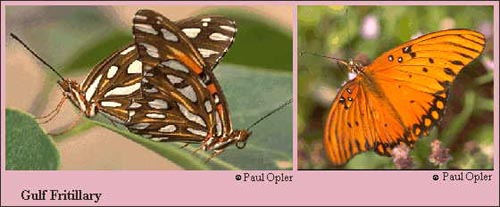Gulf Fritillary (Agraulis vanillae)

Identification: Upperside bright orange with black markings; 3 black-encircled white dots on forewing leading edge. Underside brown; forewing with orange at base; both wings with elongated, iridescent silver spots.
Life history: Males patrol for females, who lay eggs on many parts of the host plant. Caterpillars feed on most parts of the host. Adults overwinter in the south.
Flight: Throughout the year in south Florida and South Texas, January-November in the north. Number of broods has not been determined.
Caterpillar hosts: Various species of passionvine including Passiflora incarnata and P. foetida.
Adult food: Nectar from lantana, shepherd's needle, cordias, composites, and others.
Habitat: Pastures, open fields, second-growth subtropical forest and edges, city gardens.
Range: South America north through Central America, Mexico, and the West Indies to the southern United States. Wanders north to the central United States; rare northward.
Conservation: Not usually of concern.
Management needs: Cultivate host plants.
The Nature Conservancy Global Rank: G5 - Demonstrably secure globally, though it may be quite rare in parts of its range, especially at the periphery.